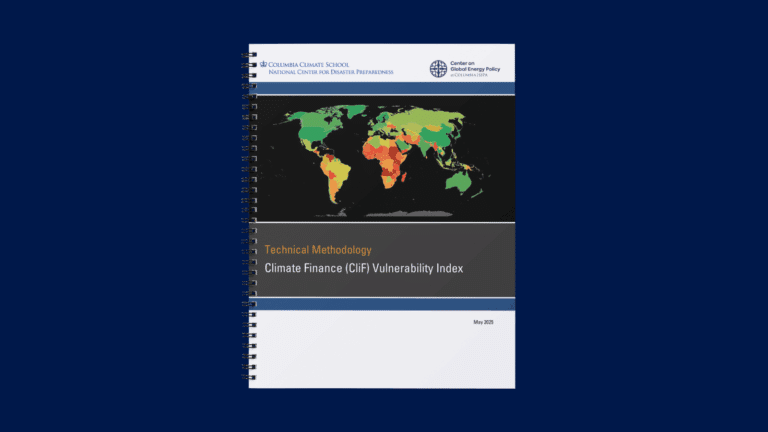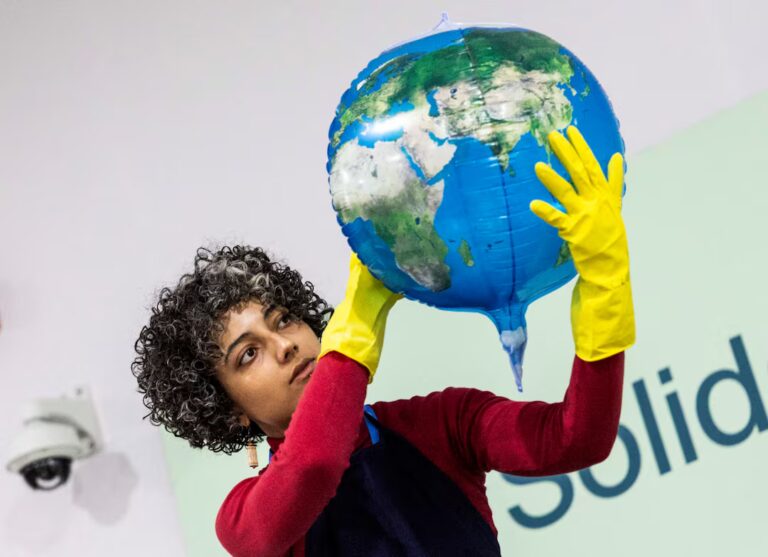Trump team pushes for ouster of top IEA official
The administration and its Republican allies in Congress say the International Energy Agency discourages fossil fuel investments around the world.
Current Access Level “I” – ID Only: CUID holders, alumni, and approved guests only
Op-eds & Essays with Jason Bordoff • March 27, 2020
The COVID-19 pandemic has disrupted daily life, caused widespread sickness and fatalities, and sent the...
The COVID-19 pandemic has disrupted daily life, caused widespread sickness and fatalities, and sent the global economy careening toward a depression. Governments have responded by taking unprecedented steps to shut down entire cities, ban travel, and isolate nations—extreme measures that are giving hope to climate activists that similarly ambitious policies might be possible to address global warming, which many consider a similar existential threat. Yet that would be the wrong lesson to draw, as the very same barriers preventing an effective COVID-19 response continue to keep climate change action out of reach.
Scientists warn that the impacts of COVID-19 will rise sharply over time, threatening the lives of vast numbers of people, particularly those most vulnerable. They warn that climate change, too, will severely harm many over time, albeit not with the same rapidity. If governments and companies can take extreme actions to cancel sports seasons, shut down workplaces, and restrict movement, surely they can take similarly drastic steps to change how we produce and consume energy?
In reality, COVID-19 reveals three reasons why fighting climate change is so hard.
First, stopping the spread of this highly contagious disease requires that we all upend our daily lives in dramatic ways—and often do so for the benefit of others. Saving lives and sparing our medical system from becoming overwhelmed requires slowing the pace of the disease’s spread. Doing that, in turn, requires a range of public health measures including avoiding contact with others, especially since those carrying the virus may not even know they have it. Many young and healthy people should be able to recover from COVID-19, but “social distancing” is necessary to help others avoid contracting the disease, particularly the elderly or those with underlying medical conditions.
In other words, “flattening the curve” of the pandemic is a classic collective action problem. Some people will choose to self-isolate to be responsible and help others, but if most others don’t do the same, there will be little benefit from that sacrifice to slow the disease’s spread. On the other hand, if everyone else self-isolates, a low-risk individual might choose to “free ride” on those sacrifices by continuing to live life as normal.
Indeed, this behavior has been pervasive during the pandemic, undermining efforts to slow the spread. Despite the public health warnings, bars and restaurants remained full in major cities like New York, beaches in Florida remained crowded, and revelers in many other places around the world continued to ignore official orders to avoid congregating. “If I get corona, I get corona,” as one spring break student in Miami nonchalantly put it.
Like COVID-19, climate change is the ultimate collective action problem. Each ton of greenhouse gas contributes equally to the problem, no matter where in the world it is produced. The United States contributes 15 percent of emissions each year; Europe, a meager 9 percent. Lawmakers in Brussels may choose to impose an economic cost on Europeans by ratcheting up the pace of decarbonization, but there will be little benefit in avoided climate impacts unless others around the world do the same.
The global nature of climate change should rally nations to do even more to address it because they want others to follow. When the Obama administration was developing an estimate for the harm to society from carbon emissions, for example, it chose to use the global rather than domestic estimate of damage precisely for this reason. Because carbon dioxide impacts are global, and every ton of CO2 contributes equally to climate change, if all nations looked only at the impact of a ton of CO2 on their own nations, the collective response would be vastly inadequate to address the true damage from climate change.
Unfortunately, too often the need for collective action is an excuse for inaction. House Republicans often argue that if China won’t commit to major emissions reductions, neither should the United States. As U.S. Sen. Lamar Alexander recently put it, “When it comes to climate change, China, India, and developing countries are the problem.”
To slow the spread of COVID-19, governments are clamping down to force collective action when individuals fail to follow guidelines. Cities across the world are shutting down businesses and events, at great cost. Yet the effectiveness of any one government’s action is limited if there are weak links in the global effort to curb the pandemic—such as from states with conflict or poor governance—even if the world is in agreement that eradicating a pandemic is in every country’s best interest. Climate change is even harder to solve because it results from the sum of all greenhouse gas emissions and thus requires aggregate effort, a problem particularly vulnerable to free-riding, as my Columbia University colleague Scott Barrett explains in his excellent book Why Cooperate? The Incentive to Supply Global Public Goods. And whereas governments can force people to stay home, there is no global institution with the enforcement power to require that nations curb emissions.
Even if the young and healthy are unpersuaded by appeals to the greater good, they should still avoid crowded beaches and bars because of the high degree of uncertainty about COVID-19, which may impact young people more than previously thought. Practicing social distancing not only helps others but is a risk mitigation strategy for oneself. Similarly, taking climate change action, even by countries less at risk than others, is a risk mitigation strategy because of the high degree of uncertainty over how severe the impacts of climate change will end up being—the so-called “of climate risk.
The second sobering lesson from COVID-19 for climate change efforts is the importance of public buy-in and education. The problems of collective action described above are less acute when the public broadly understands the gravity of the threat.
After suffering from failed responses to previous disease outbreaks, several Asian countries learned their lessons and have responded to COVID-19 far more rapidly than the United States and those in Europe. Residents of Hong Kong, for example, which suffered during the SARS epidemic, canceled gatherings and practiced social distancing before the government even ordered it because they understood the risks.
While public concern with climate change is rising, there remains a long way to go. Only half of Americans believe climate change should be a top priority for the federal government, and the figure is far lower on the Republican side of the aisle.
Indeed, COVID-19 itself may actually erode public support for stronger climate action, as the pace of climate ambition wanes during times of economic hardship. Historically, there is an inverse relationship in the United States and Europe between public concern about the environment and worries about economic conditions. Similarly, concern about economic growth has often caused China to ratchet back its environmental ambitions. Just last week, China was reportedly considering relaxing emissions standards to help struggling automakers.
The third reason COVID-19 should give pause to expectations about climate change action is because of what it reveals about the strong link between carbon emissions and economic activity.
For decades, the energy intensity, and thus carbon intensity, of economic growth has declined, as economies become more energy-efficient. Each unit of economic growth contributes less to carbon emissions than it previously did. From 2014 to 2016, global greenhouse gas emissions did not rise at all, leading many to celebrate that emissions and economic growth had decoupled. Yet there remained a strong relationship between growth and energy use. As Harvard’s Robert Stavins pointed out, the rate of gross domestic product growth still very much affects emissions, as slower growth would have led emissions to fall.
As COVID-19 brings the global economy to a standstill, economists worry about not just a recession, but even a global depression. In the United States alone, a record 3.3 million workers filed for unemployment benefits last week, a number likely to rise sharply. On the stock market, the Dow Jones index wiped out all the gains of Donald Trump’s presidency before rebounding on reports the U.S. Congress would pass a stimulus bill. As air travel and other transport is ratcheted back globally, oil demand has fallen by around 20 percent, and analysts estimate it will be down by at least 5 percent in all of 2020 compared to last year. A huge hit to economic growth would likely mean carbon emissions will fall in 2020 for the first time since the Great Recession of 2008.
That may seem like good news, but it is not. First of all, economic contractions are not a desirable or sustainable way to curb emissions; emissions rebounded sharply after 2009. More importantly, the fact that it takes severe economic slowdowns like the Great Recession or COVID-19 to bring emissions down serves as a reminder of just how strongly tied emissions remain to economic growth—and thus how hard it is to lower them.
That is why energy from renewable sources can grow as rapidly as it has over the past decade and yet fossil fuel use can keep rising at the same time as total energy use rises around the world, especially in fast-growing economies like China and India. As one example, Marianne Kah, an economist at the Center on Global Energy Policy, deconstructed a range of projections of oil demand growth to understand why analysts differ on when oil demand will peak and found that assumptions about economic growth are as important as assumptions about the penetration of electric vehicles.
Policymakers have spent trillions of dollars and passed countless regulations, standards, and mandates to spur clean energy. That it takes a pandemic-induced economic standstill to actually bring emissions down should be a sobering reminder of just how hard addressing climate change will be as living standards, fortunately, continue to rise in emerging markets.
COVID-19 may deliver some short-term climate benefits by curbing energy use, or even longer-term benefits if economic stimulus is linked to climate goals—or if people get used to telecommuting and thus use less oil in the future.
Yet any climate benefits from the COVID-19 crisis are likely to be fleeting and negligible. Rather, the pandemic is a reminder of just how wicked a problem climate change is because it requires collective action, public understanding and buy-in, and decarbonizing the energy mix while supporting economic growth and energy use around the world.
The Climate Finance (CliF) Vulnerability Index is designed to provide a comprehensive understanding of climate vulnerability for nation states in order to improve the targeting and provision of climate change adaptation financing.

Energy abundance isn't a climate strategy—it delays clean energy progress, harms global cooperation, and repeats past policy mistakes.

Full report
Op-eds & Essays with Jason Bordoff • March 27, 2020